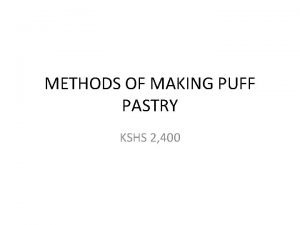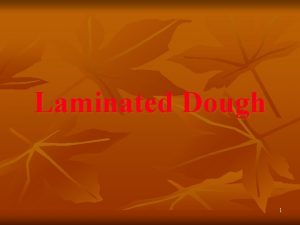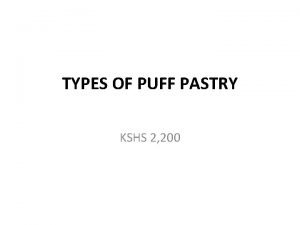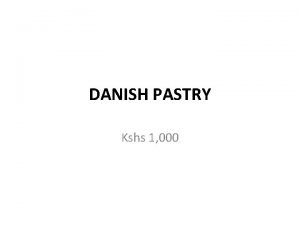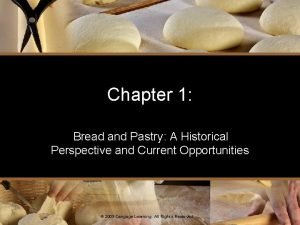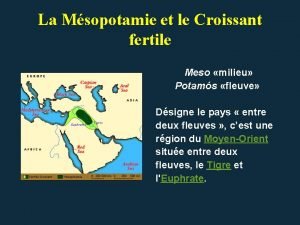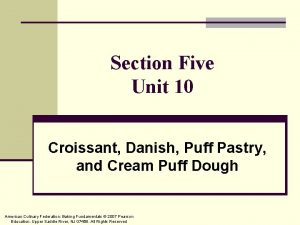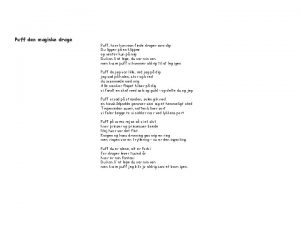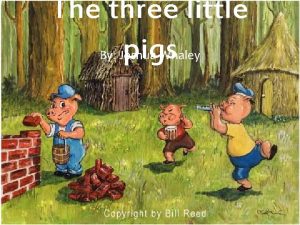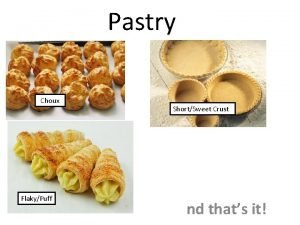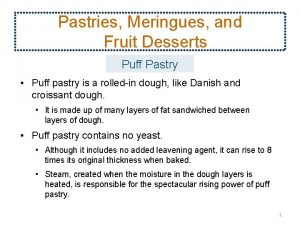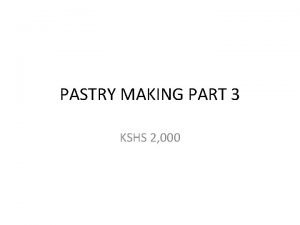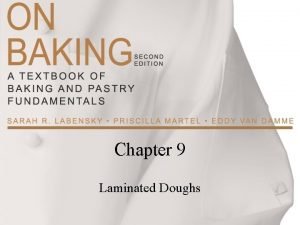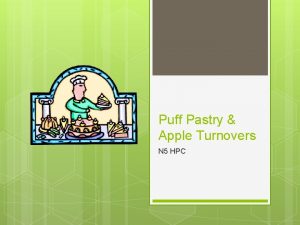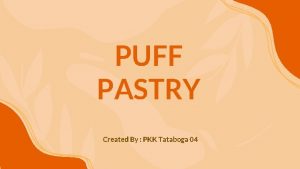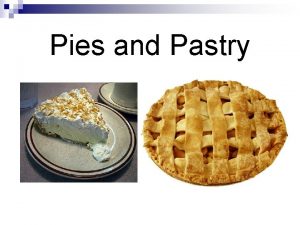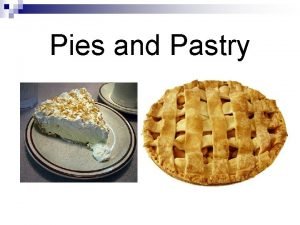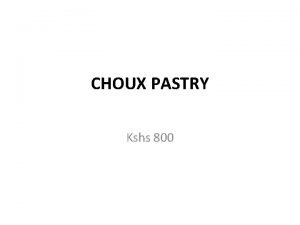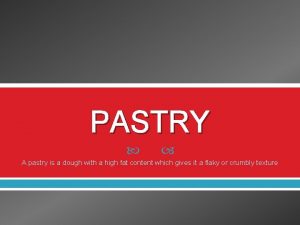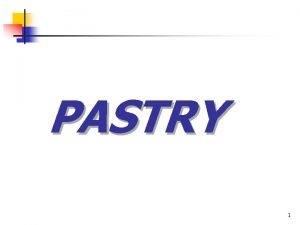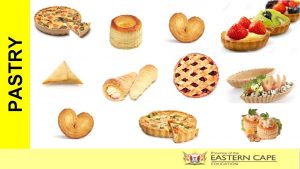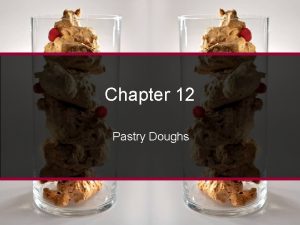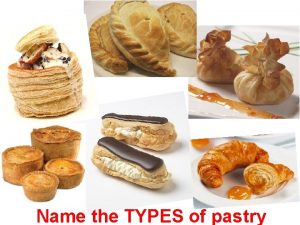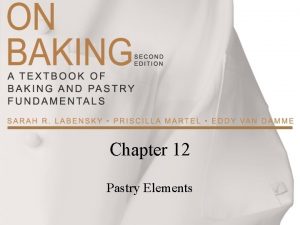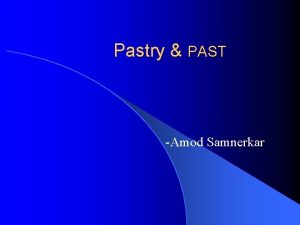Section Five Unit 10 Croissant Danish Puff Pastry

























- Slides: 25

Section Five Unit 10 Croissant, Danish, Puff Pastry, and Cream Puff Dough American Culinary Federation: Baking Fundamentals © 2007 Pearson Education. Upper Saddle River, NJ 07458. All Rights Reserved

Objectives n Control fat, dough consistency, and temperature for lamination n Calculate the required number of folds for different type of fats and dough n Describe how to condition, retard, proof, and rest various laminated dough n Demonstrate how to condition, shape, retard, proof, and bake croissant dough American Culinary Federation: Baking Fundamentals © 2007 Pearson Education. Upper Saddle River, NJ 07458. All Rights Reserved 2

Objectives (continued) n Demonstrate how to condition, shape, retard, proof, and bake Danish dough n Demonstrate how to cook, mix, shape, and bake cream puff dough n Demonstrate how to make a variety of pastries using puff pastry dough American Culinary Federation: Baking Fundamentals © 2007 Pearson Education. Upper Saddle River, NJ 07458. All Rights Reserved 3

Terms to Know Specific terms to know from this unit: ü Croissants ü Pâté à choux ü Danish ü Pliable ü Hydrate ü Puff pastry ü Knead ü Savory ü Lamination ü Steam ü Laminated dough American Culinary Federation: Baking Fundamentals © 2007 Pearson Education. Upper Saddle River, NJ 07458. All Rights Reserved 4

Laminated Dough n Process of layering dough and fat (butter) n When baked, the fat works into the layers of dough and gives off moisture n Uses high percentage of fat, making the product flaky and tender n Some laminated dough uses yeast (croissant), while others do not (puff pastry) American Culinary Federation: Baking Fundamentals © 2007 Pearson Education. Upper Saddle River, NJ 07458. All Rights Reserved 5

Laminated Dough Ingredients n Flour n Use 11 -12% protein flour for croissants n For richer Danish dough, use a blend of 80% bread flour and 20% pastry flour (or just use all purpose flour) n Water / Milk n Water only for croissant and puff pastry dough n Water and milk for Danish and cream puff dough (to sweeten and color) American Culinary Federation: Baking Fundamentals © 2007 Pearson Education. Upper Saddle River, NJ 07458. All Rights Reserved 6

Laminated Dough Ingredients (continued) n Sugar n Small amount of sugar in croissant dough (for fermentation and carmelization) n Danish dough needs more sugar n Puff pastry and cream puff dough do not have sugar n Yeast n Used for leavening in croissant and Danish dough n Not used in puff pastry or cream puff dough American Culinary Federation: Baking Fundamentals © 2007 Pearson Education. Upper Saddle River, NJ 07458. All Rights Reserved 7

Laminated Dough Ingredients (continued) n Fat n Important role for structure in product n Type of fat affects product; types: n n Butter – Most expensive, but best flavor Margarine – Less expensive with higher melting point Shortening – May be used in cream puff dough, but not used in others Eggs – Used in Danish dough for color and texture, but not used on others n Salt - Added to aid in fermentation process in croissant and Danish dough American Culinary Federation: Baking Fundamentals © 2007 Pearson Education. Upper Saddle River, NJ 07458. All Rights Reserved 8

Laminated Dough Methods n Leavening comes from steam generated by n n moisture from within layers of dough Keep fat and dough even in continuous layers Fat must not be cold, but firm enough to spread evenly Number of folds is determined by the percentage and type of fat – more fat = more layers Let dough rest for 30 minutes in refrigerator between folds American Culinary Federation: Baking Fundamentals © 2007 Pearson Education. Upper Saddle River, NJ 07458. All Rights Reserved 9

Laminated Dough Methods Tri-fold method Fat American Culinary Federation: Baking Fundamentals © 2007 Pearson Education. Upper Saddle River, NJ 07458. All Rights Reserved Dough 10

Laminated Dough Methods Tri-fold method Fat American Culinary Federation: Baking Fundamentals © 2007 Pearson Education. Upper Saddle River, NJ 07458. All Rights Reserved Dough 11

Laminated Dough Methods Tri-fold method Fat American Culinary Federation: Baking Fundamentals © 2007 Pearson Education. Upper Saddle River, NJ 07458. All Rights Reserved Dough 12

Laminated Dough Methods n Continue with folds until desired folds is achieved n Puff pastry dough has a higher percentage of fat and can be layered with quarter folds n Important tips: n n Square corners Overlap all areas Chill between folds Alternate 90° between folds American Culinary Federation: Baking Fundamentals © 2007 Pearson Education. Upper Saddle River, NJ 07458. All Rights Reserved 13

Laminated Dough Methods n Dusting flour keeps dough from sticking, but do not use excessive flour n Roll to uniform thickness n Keep track of number of folds n Remember that laminating dough is an allday process – don’t rush it American Culinary Federation: Baking Fundamentals © 2007 Pearson Education. Upper Saddle River, NJ 07458. All Rights Reserved 14

Croissant Dough American Culinary Federation: Baking Fundamentals © 2007 Pearson Education. Upper Saddle River, NJ 07458. All Rights Reserved 15

Croissant Dough Recipe Croissant Dough % Ratio Ingredients 100% Weights English Metric Bread flour 2 lb, 10 oz 1190 g 57% Milk 1 -½ lb 680 g 7% Yeast 3 oz 90 g 2% Salt 1 oz 30 g 7% Sugar 3 oz 90 g 9% Butter (soft) 4 oz 110 g Roll-in 72% Butter 2 lb 900 g 4% Bread flour 2 oz 60 g American Culinary Federation: Baking Fundamentals © 2007 Pearson Education. Upper Saddle River, NJ 07458. All Rights Reserved Notes Use straight dough mixing method. 65°F (18°C) dough temperature. Knead until pliable. Bake at 375°F (190°C) 16

Danish Dough American Culinary Federation: Baking Fundamentals © 2007 Pearson Education. Upper Saddle River, NJ 07458. All Rights Reserved 17

Danish Dough Recipe Danish Dough % Ratio Ingredients 44% Weights English Metric Milk (cold) 1 lb 450 g 11% Yeast 4 oz 110 g 22% Egg yolks 8 oz 230 g 14% Sugar 5 oz 140 g 2% Salt ½ oz 10 g 4% Butter (soft) 4 oz 110 g 35% Pastry flour 12 oz 340 g 65% Bread flour 1 -½ lb 680 g Cardamom 1/8 oz 5 g Roll-in 76% Butter or margarine American Culinary Federation: Baking Fundamentals © 2007 Pearson Education. Upper Saddle River, NJ 07458. All Rights Reserved 1 -½ lb 680 g Notes Place milk, yeast and egg yolks in bowl. Stir and add balance of ingredients (without roll-in). Mix on slow, then medium. Bake at 380°F (190°C) 18

Danish Dough Fillings n Almond n Cream cheese n Baker’s cheese n Hazelnut n Fruit n Apple n Cherry n Raspberry American Culinary Federation: Baking Fundamentals © 2007 Pearson Education. Upper Saddle River, NJ 07458. All Rights Reserved 19

Puff Pastry Dough American Culinary Federation: Baking Fundamentals © 2007 Pearson Education. Upper Saddle River, NJ 07458. All Rights Reserved 20

Puff Pastry Dough Recipe Puff Pastry Dough Weights % Ratio Ingredients Notes English Metric 100% Bread flour 2 lb 900 g 58% Water 1 lb, 2 oz 480 g 12% Yeast 4 oz 110 g 2 -½% Salt 1 oz 30 g Combine and mix until smooth. Chill for 30 min. Roll-in 100% Butter 2 lb 900 g 12% Flour 4 oz 110 g American Culinary Federation: Baking Fundamentals © 2007 Pearson Education. Upper Saddle River, NJ 07458. All Rights Reserved Knead with flour sheet. Bake at 400°F (200°C) 21

Cream Puff Dough (Pâté à Choux) American Culinary Federation: Baking Fundamentals © 2007 Pearson Education. Upper Saddle River, NJ 07458. All Rights Reserved 22

Cream Puff Dough Recipe Cream Puff Dough (Pâté à choux) Weights % Ratio Ingredients Notes English Metric 66% Water 1 lb 450 g 66% Milk 1 lb 450 g 2% Salt 3 oz 90 g 66% Butter 1 oz 30 g Roll-in 100% Flour 1 -½ lb 680 g 133% Eggs 2 lb 900 g American Culinary Federation: Baking Fundamentals © 2007 Pearson Education. Upper Saddle River, NJ 07458. All Rights Reserved Bring to boil. Add flour, stir. Cool to 100°F (38°C) then add eggs. Bake at 400°F (200°C) for 12 -15 min. , then at 360°F (180°C) until done. 23

Troubleshooting Cream Puff Dough Problems Problem Solution • Break fat into pieces (so water does not boil), causing imbalanced formula Mix is too firm • Avoid prolonged cooking after the flour has been added • Cool sufficiently before adding eggs • Watch the size of the eggs (if the recipe gives eggs in numbers) Cracks in the shells • Lower the initial oven temperature • Add more liquid to decrease mix stiffness Shells do not rise • Add more liquid to decrease mix stiffness • Decrease the oven temperature Shells collapse • Add more flour to firm the mix • Increase the bake time for the shells • Do not open the oven during the first stage of baking • Avoid slamming the oven door or hitting pans against the oven wall Lumps in the mix • Incorporate the eggs sufficiently between each addition • Decrease the amount of eggs in each addition American Culinary Federation: Baking Fundamentals © 2007 Pearson Education. Upper Saddle River, NJ 07458. All Rights Reserved 24

Summary n Lamination is the process of layering dough and fat (butter) n When baked, the fat works into the dough and gives off steam – making the dough layers flaky and tender n Rolling and folding the dough creates multiple layers n n Croissant and Danish dough are generally given 3 trifolds, creating 135 layers of pastry Puff pastry can have over 1, 000 layers n Cream puff dough (pâté à choux) can be used to make hollow shells, which can be filled with creams, custards, or other savory fillings American Culinary Federation: Baking Fundamentals © 2007 Pearson Education. Upper Saddle River, NJ 07458. All Rights Reserved 25
 Puff pastry scotch method
Puff pastry scotch method Types of laminated dough
Types of laminated dough Types of puff
Types of puff Puff the magic dragon dansk
Puff the magic dragon dansk Danish pronunciation
Danish pronunciation Danish pastry adalah
Danish pastry adalah Pastry pastry
Pastry pastry Croissant fertile fleuves
Croissant fertile fleuves Lordre croissant
Lordre croissant Ghardaa
Ghardaa Indien cherokee islam
Indien cherokee islam Ensb constantine
Ensb constantine Cout de renonciation croissant
Cout de renonciation croissant Lune quartier croissant
Lune quartier croissant Pharaon
Pharaon Lordre croissant
Lordre croissant Au diner je mange
Au diner je mange Why do turkeys puff up
Why do turkeys puff up Jog clay die scream
Jog clay die scream Lived by the sea
Lived by the sea Puff den magiske drage
Puff den magiske drage Three little pigs once upon a time
Three little pigs once upon a time Huff puff blow
Huff puff blow Choux flaky puff short
Choux flaky puff short French east india company
French east india company Denmark airspace
Denmark airspace
